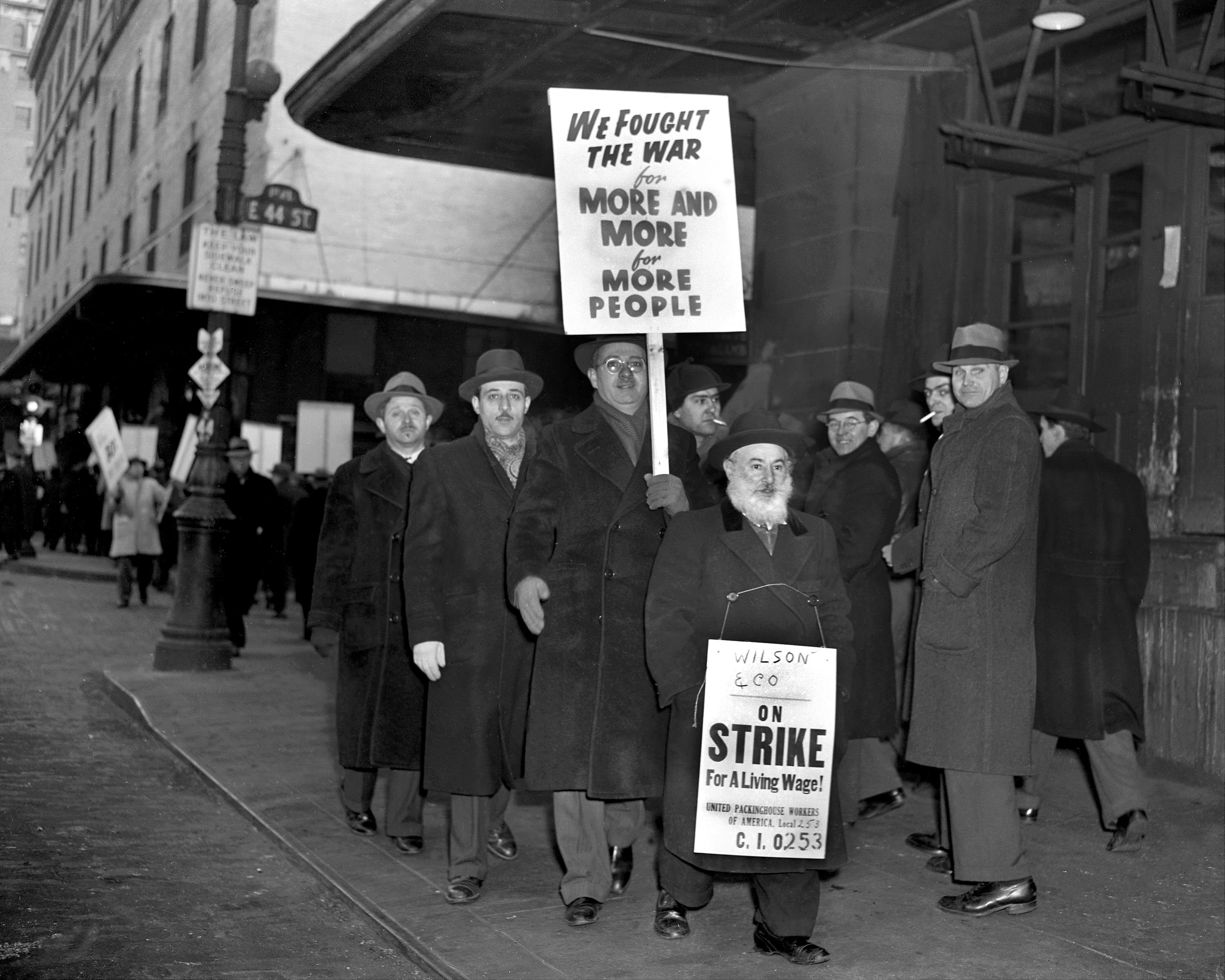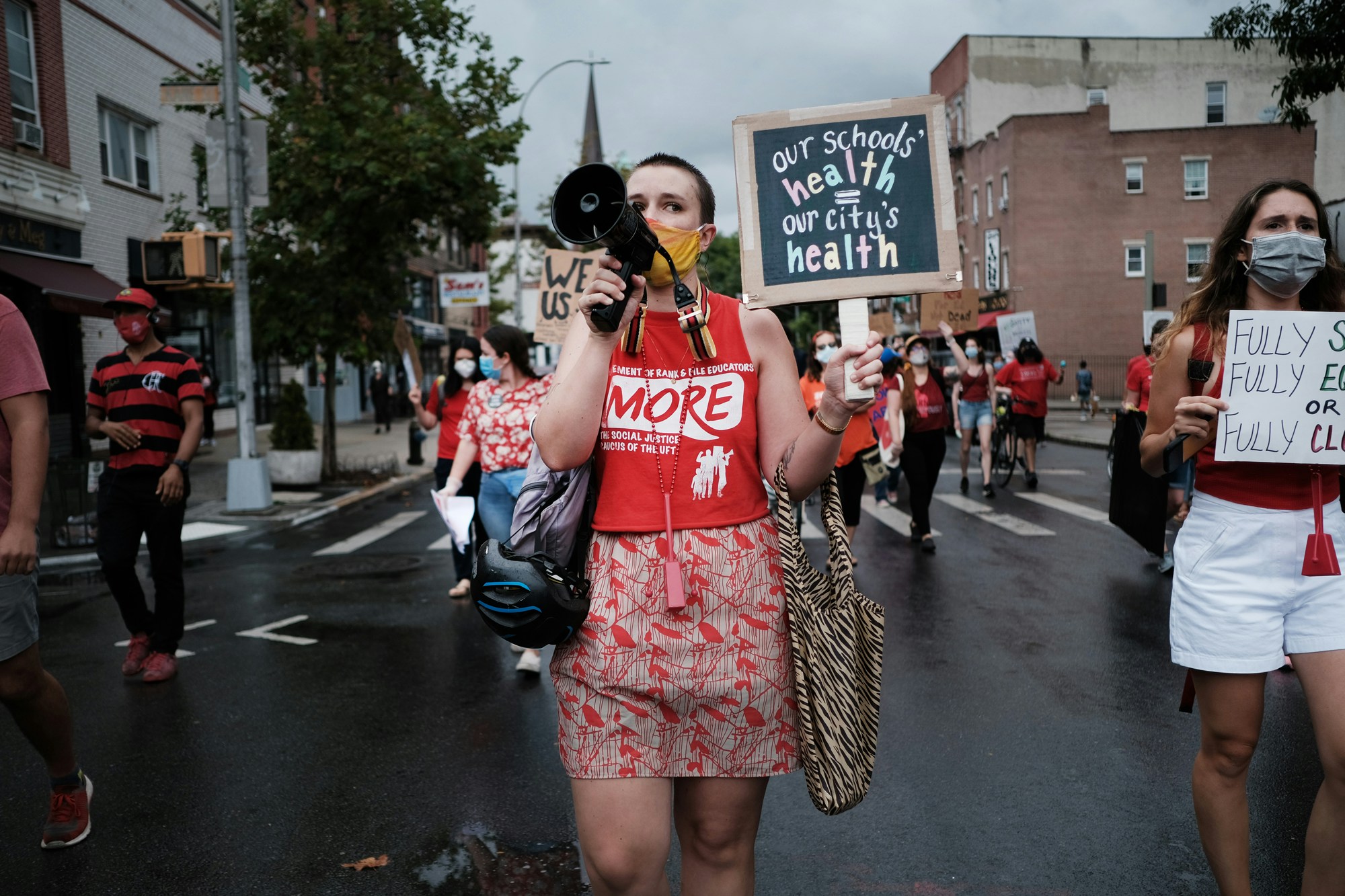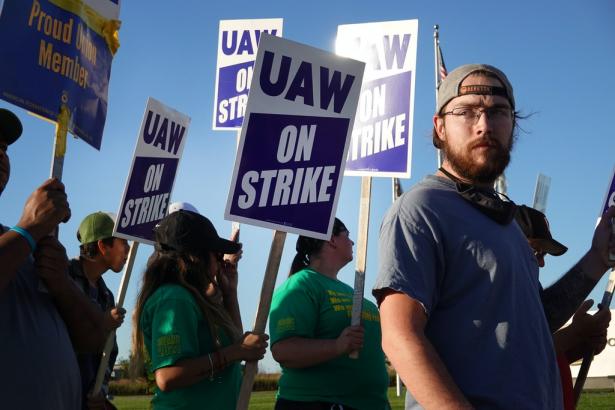Shortly before midnight on Wednesday, production workers at a John Deere facility in Waterloo, Iowa, started shutting down the plant, quenching the furnaces in the foundry. The plant was already mostly empty, with Deere telling overnight workers to stay home. Three days earlier, union members at United Auto Workers meetings in Iowa, Illinois, and Kansas had voted overwhelmingly to reject a proposed contract that gave subinflation raises and eliminated pensions for all new hires. The rejection came as a surprise to both the union leadership and the company; even some of the workers who had voted no and authorized a strike were surprised that it was actually happening. The 10,000 workers who walked off the job are striking Deere for the first time in 35 years. “Just confirmed Waterloo has their picket signs,” one worker said before the strike began. “Shit’s about to get real.”
They join 2,000 hospital workers striking in Buffalo, New York; 1,400 production workers for Kellogg’s in four states; 450 steelworkers in Huntington, West Virginia; and a one-day walk-off of 2,000 telecommunications workers in California, all since October 1. One thousand Alabama coal miners, 700 nurses in Massachusetts, 400 whiskeymakers in Kentucky, and 200 bus drivers in Reno, Nevada, were already on strike, in addition to recently settled strikes by 2,000 carpenters in Washington, 600 Frito-Lay workers in Kansas, and 1,000 Nabisco factory workers at five plants across the country.
And there are tens of thousands of workers waiting in the wings, with 37,000 health care workers at Kaiser in Oregon, California, and Hawaii who have either authorized a strike or are about to as well as several large unions of academic workers also readying to strike. More than 60,000 film and television workers were prepared to walk out, with 90 percent of International Alliance of Theatrical Stage Employees members voting 98 percent to strike, before a tentative contract was reached on Saturday. A vote on whether to ratify that contract will be held in the next several weeks.
This strike wave isn’t the 1940s, when 1 in 10 U.S. workers went on strike in the space of a year. But it isn’t the labor lull of the 2010s, either, when large strike activity in the private sector fell toward zero. Today, workers are increasingly militant — that is, unwilling to accept bad terms of employment — but they are not particularly organized. With union density at a historical nadir, the unions are playing an inspirational role, but they aren’t the only source of the action. What we’re seeing now is strike activity beginning to rise from a decadeslong trough as the “essential” worker — a new category of worker born of the coronavirus pandemic — challenges the boss to make good on that designation.
It’s not just workers taking note of the potential power shift; Wall Street analysts also sounded the alarm on Deere’s stock price this week, with one analyst downgrading projections by 25 percent. In a section of a proprietary report titled “Pendulum of Power Has Swung,” the analyst wrote: “Members, in addition to wanting concessions from Deere regarding a new 6-yr labor agreement, could also be tying these negotiations in with their desire to change how UAW national leadership is elected, and a broader national (and if global) enhanced activism by labor as they see their increasing power in a tight labor market.”
THE WOEBEGONE SMALL business owner who can’t attract workers has been one of the media’s favorite protagonists of the Build Back Better era, partly as cover for the Fortune 100 CEOs like Deere’s John C. May who benefit from the same low-wage labor market. But that tight labor market, a problem from the perspective of employers, has a mirror image in the eyes of those workers who never left the workplace: the “essential” and “front-line” and “hero” workers. Inside the workplace, workers across all industries, from transit to health care to logistics to food manufacturing, are beset by understaffing, which leads to forced overtime and burnout. In slaughterhouses, nursing homes, and countless other worksites, Covid-19 gave a new intensity to the existing landscape of occupational hazard: In 2020, nursing assistant became the most dangerous job in America.
Workers are also feeling the heat of the past year’s market basket inflation. Kaiser’s 1 percent raise offer (on top of the introduction of an average 26 percent wage cut for all new hires) becomes a wage cut against a 5 percent consumer goods inflation. The 15-cent-per-hour raise International Brotherhood of Electrical Workers construction workers are getting in Orlando, Florida, doesn’t come close to keeping up with the rising cost of living. Kellogg’s proposal includes cutting the cost-of-living adjustment, which was once a central part of collective bargaining in core industries but which never came back for Big Three autoworkers after the 2008 financial crisis and auto bankruptcies. Core to several of these strikes — Deere, Kellogg’s, and Kaiser — is a revolt against the 1980s-era introduction of “two-tier” contracts that provide worse conditions for new hires. As Bakery, Confectionery, Tobacco Workers and Grain Millers’ International Union Local 3G president and Kellogg’s strike leader Trevor Bidelman told Labor Notes, “The future’s not for sale.”
In the case of Deere, workers are well aware of the company’s record profits and aren’t moved by what amounts to a $1-per-hour wage increase for most of them. The members have long self-organized into a Facebook group called “Post ’97,” meaning employees hired after 1997, with worse wages, benefits, and pensions. The current contract for most “post-’97” workers would be a 6-cent raise from what “pre-’97” workers made 10 years ago. The company’s proposal to cut pensions for all new hires — creating a “post-’21” workforce — runs up against a moral opposition that aligns with a new economic playing field, causing many workers to tout as a core demand of the strike: “No third tier!”
But a tight labor market also means leverage for workers. Knowing that they’re harder to replace, individual workers become more likely to say no to bosses: Today, workers are quitting their jobs at the highest rate in decades — one of the most precise measures of their labor market power as individuals. Where workers are organized collectively into unions, tight labor markets lead to rising willingness to confront employers over the terms and conditions of employment, instead of just looking for a better deal elsewhere. In other words, the same forces making work intolerable for so many — not enough workers and too much work — are simultaneously preparing workers to fight back.

Employers at kosher meat departments picket at First Avenue and 44th Street in Chicago on Jan. 16, 1946. Photo: John Tresilian/NY Daily News via Getty Images
The end of a national mobilization also tends to release built-up pressures in the workplace. Workers who put up with suppressed wages or stressful working conditions during an emergency expect to see something change afterward. As Harold Meyerson recently observed, both 1919 and 1945-1946 saw massive strike waves as the world wars ended. In the 1945-1946 cycle, when more than 10 percent of American workers went on strike, events that could plausibly be called general strikes erupted in Stamford, Connecticut; Lancaster, Pennsylvania; Rochester, New York; Pittsburgh, Pennsylvania; and Oakland, California.
The release valve that may be opening now resumes an expansion of labor activity before the pandemic. The generation before the 2008 crisis had been marked by long-term stagnation of wages and decline in labor’s share of national income. Recoveries from recessions in the 1980s, 1990s, and 2000s took longer than in earlier years, and large numbers of workers got stranded in permanent underemployment or inactivity. These trends culminated in the Great Recession and its agonizing, protracted recovery. But unemployment finally fell below 4 percent in 2018, and that year and the next, a noticeable uptick in strike activity occurred — most notably in a massive teachers’ strike wave — when labor markets had finally recovered from the devastation that followed the 2008 financial crisis, but teachers’ wages had not.
In terms of strike activity, the current private sector wave picks up where the teachers left off, after an interlude of relative inaction during the height of the pandemic. In 2020, moreover, teachers formed the first major group of workers to refuse to accept whatever terms the employer dictated for reopening the workplace. It is difficult to imagine teachers speaking out against returning to work in unsafe conditions as much as they did without the national wave of militant teachers’ strikes in the two preceding years. This resistance has now spread across the economy, in both organized and individual forms.

Members of the teachers union, parents, and students march through Brooklyn to demand a safer teaching environment for themselves and for students during the Covid-19 pandemic on Sept. 1, 2020, in New York. Photo: Spencer Platt/Getty Images
TODAY, WORKERS’ ECONOMIC resistance — whether through organized strikes or in the refusal of dangerous, underpaid, and unappealing jobs — is shaping the political agenda. Many of the policies in the Democrats’ $3.5 trillion budget proposal would pursue the same ends as workers’ actions but in the realm of social policy. Proposed subsidies for home health care and child care, the child tax credit, Medicaid expansion, and investments in housing and green energy would all indirectly support workers’ power. Either by increasing demand for labor further or by alleviating some of the grotesque social pressures that have forced employees to accept whatever terms employers offered them, the federal government would strengthen workers’ bargaining position. When Sen. Joe Manchin, D-W.Va., warns against becoming an “entitlement society,” what he is opposing is the shift in labor market power that such policy measures help secure.
The heightened interplay between industrial and political disputes marks a break with recent history. Through much of the last generation, even militant industrial action often bore little explicitly political significance. A major strike like the one at UPS in 1997 or Verizon in 2016 won gains for workers, but such events remained economic affairs. Politicians might feel compelled to comment on them — as former President Bill Clinton did about the UPS strike — but such disputes didn’t raise or settle any larger political question about the balance of power between the classes. (After providing a carefully neutral comment urging UPS and the Teamsters to settle, Clinton headed straight to Martha’s Vineyard.)
In the last several years, a number of mainstream Democrats have come to accept what had previously been a left-wing argument: that the increase of social inequality and the decline in working-class economic security is the ultimate cause of the destabilization of American democracy and must be taken head on. The stated position of the Biden administration is that “the decline of union density has … weakened our democracy.”
When organized labor is stronger, widespread dissatisfaction takes a more coordinated form. With higher levels of union membership, organized workers’ militancy generates concentrated pressure on targeted firms and triggers dissension among employers. Some bosses start to squirm and seek to calm labor down by agreeing to progressive social reforms, while others insist on holding the line. Those caught in the middle, like salaried employees at Deere, may largely sympathize with the strikers while being forced to work through the strike despite a serious skills gap.
The lower level of workers’ organization today — the smaller size of the organized workforce compared to an angry but scattered mass — makes it more difficult to divide employers politically in this way. On the picket lines and on Capitol Hill, the political capacity of a shrunken labor movement is being tested. The more concrete gains workers win now in either arena, the more others among the unorganized millions will see the benefits of unity.
PRESIDENT JOE BIDEN styles himself as labor’s champion, aspiring to be “the most pro-union president you’ve ever seen.” Days before he launched his presidential campaign (using a Pittsburgh union hall for his stage), Biden appeared on the picket line of one of the major strikes of 2019, at the Stop & Shop grocery chain in New England. Recently, confronted with businesses having a hard time hiring staff, the president said, “Pay them more.”
But when asked to take sides, he’s stuck to official neutrality, his press secretary citing unspecified “legal reasons.” On Friday, when asked about the John Deere strike, he stated, obviously, “They have a right to strike. They have a right to demand higher wages. … I’m not getting into the negotiation.”
And the administration has allowed key pro-worker provisions in the American Rescue Plan Act to expire, such as subsidies for COBRA, which are particularly crucial for striking workers whose employers cut off health insurance. The Allegheny Technologies Inc. workers, part of the United Steelworkers union, who struck for five months this year had the benefit of federally subsidized COBRA; the UAW members currently striking John Deere, whose employer plans to cut them off their plans by October 27, will not. They would, however, be eligible for other subsidies, including heavily subsidized Obamacare plans, though that would entail changing plans and potentially medical networks.
Ultimately, the issue in dispute across these strikes is whether American workers can be muscled back into the punishing labor market conditions of the pandemic and the several decades that preceded Covid-19 that made the pandemic so brutal within the insecure and unequal American workplace. Will nonunion workers settle for low wages and dangerous conditions? Will union workers continue to ratify two-tier contracts with incremental givebacks to employers? When the U.S. worker “goes back” to work, what kind of economy will they be going back to?
This is precisely the same issue as the one roiling Capitol Hill right now: whether Congress’s role is to return us to a pre-pandemic status quo or to intervene on the side of a battered working class.
Correction: Monday, October 18, 2021
The vote to ratify IATSE’s tentative contract will be held in the next several weeks, with locals planning to provide more information in the coming days. The piece originally stated the vote would take place this week.


Spread the word